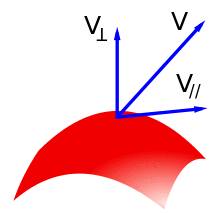In mathematics, given a vector at a point on a curve, that vector can be decomposed uniquely as a sum of two vectors, one tangent to the curve, called the tangential component of the vector, and another one perpendicular to the curve, called the normal component of the vector. Similarly a vector at a point on a surface can be broken down the same way.
More generally, given a submanifold N of a manifold M, and a vector in the tangent space to M at a point of N, it can be decomposed into the component tangent to N and the component normal to N.
Formal definition
Surface
More formally, let be a surface, and be a point on the surface. Let be a vector at Then one can write uniquely as a sum
where the first vector in the sum is the tangential component and the second one is the normal component. It follows immediately that these two vectors are perpendicular to each other.
To calculate the tangential and normal components, consider a unit normal to the surface, that is, a unit vector perpendicular to at Then,
and thus
where "" denotes the dot product. Another formula for the tangential component is
where "" denotes the cross product.
Note that these formulas do not depend on the particular unit normal used (there exist two unit normals to any surface at a given point, pointing in opposite directions, so one of the unit normals is the negative of the other one).
Submanifold
More generally, given a submanifold N of a manifold M and a point , we get a short exact sequence involving the tangent spaces:
The Quotianifold, the above sequence splits, and the tangent space of M at p decomposes as a direct sum of the component tangent to N and the component normal to N:
Thus every tangent vector splits as , where and .
Computations
Suppose N is given by non-degenerate equations.
If N is given explicitly, via parametric equations (such as a parametric curve), then the derivative gives a spanning set for the tangent bundle (it's a basis if and only if the parametrization is an immersion).
If N is given implicitly (as in the above description of a surface, or more generally as a hypersurface) as a level set or intersection of level surfaces for , then the gradients of span the normal space.
In both cases, we can again compute using the dot product; the cross product is special to 3 dimensions though.
Applications
- Lagrange multipliers : constrained critical points are where the tangential component of the total derivative vanish.
- Surface normal
References
- Rojansky, Vladimir (1979). Electromagnetic fields and waves. New York: Dover Publications. ISBN 0-486-63834-0.
- Benjamin Crowell (2003) Light and Matter. (online version).
